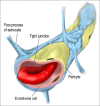Poop for thought: Can fecal microbiome transplantation improve cognitive function in aging dogs?
- PMID: 40201831
- PMCID: PMC11974304
- DOI: 10.5455/OVJ.2025.v15.i2.6
Poop for thought: Can fecal microbiome transplantation improve cognitive function in aging dogs?
Abstract
Canine cognitive dysfunction (CCD) is the dog version of human Alzheimer's disease (AD), and it has strikingly similar pathological features to those of this neurodegenerative disorder. The gastrointestinal system is in constant communication with the brain via several conduits collectively termed the gut-brain axis. The microbial population of the gut, referred to as the microbiota, has a profound effect on the interactions that occur along this communication route. Recent evidence suggests that dysbiosis, an abnormal gastrointestinal microbial population, is linked to cognitive impairment in rodent AD models and human AD. There is also evidence from rodent AD models that correcting dysbiosis by transferring fecal material from healthy donors to the gastrointestinal tracts of cognitively impaired recipients [fecal microbiome transplantation (FMT)] reverses AD-associated brain pathology and improves cognitive function. Although limited, some clinical reports have described the improvement of cognitive function with FMT in human AD. The goals of this review article are to provide an overview of the mechanisms involved in dysbiosis- associated cognitive decline and the role of FMT in therapy for such decline. The potential role of FMT in CCD is also discussed.
Keywords: Alzheimer’s; Canine; Cognitive; Fecal; Gut–brain axis; Microbiota; Transplantation; dysfunction.
Conflict of interest statement
There are no conflicts of interest with this article.
Figures



Similar articles
-
Fecal Microbiota Transplantation in Dogs.Vet Clin North Am Small Anim Pract. 2021 Jan;51(1):219-233. doi: 10.1016/j.cvsm.2020.09.012. Epub 2020 Oct 29. Vet Clin North Am Small Anim Pract. 2021. PMID: 33131919 Review.
-
Fecal Microbiota Transplantation Improves Cognitive Function of a Mouse Model of Alzheimer's Disease.CNS Neurosci Ther. 2025 Feb;31(2):e70259. doi: 10.1111/cns.70259. CNS Neurosci Ther. 2025. PMID: 39957504 Free PMC article.
-
Safety profile and effects on the peripheral immune response of fecal microbiota transplantation in clinically healthy dogs.J Vet Intern Med. 2024 May-Jun;38(3):1425-1436. doi: 10.1111/jvim.17061. Epub 2024 Apr 13. J Vet Intern Med. 2024. PMID: 38613431 Free PMC article.
-
Fecal Microbiota Transplantation (FMT) From a Human at Low Risk for Alzheimer's Disease Improves Short-Term Recognition Memory and Increases Neuroinflammation in a 3xTg AD Mouse Model.Genes Brain Behav. 2025 Feb;24(1):e70012. doi: 10.1111/gbb.70012. Genes Brain Behav. 2025. PMID: 39801363 Free PMC article.
-
Gut Microbiome in Alzheimer's Disease: from Mice to Humans.Curr Neuropharmacol. 2024;22(14):2314-2329. doi: 10.2174/1570159X22666240308090741. Curr Neuropharmacol. 2024. PMID: 39403057 Free PMC article. Review.
References
-
- Alessandri G, Milani C, Mancabelli L, Mangifesta M, Lugli G.A, Viappiani A, Duranti S, Turroni F, Ossiprandi M.C, van Sinderen D, Ventura M. Metagenomic dissection of the canine gut microbiota: insights into taxonomic, metabolic and nutritional features. Env. Microbiol. 2019;21:1331–1343. - PubMed
Publication types
MeSH terms
LinkOut - more resources
Full Text Sources
Medical
